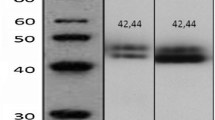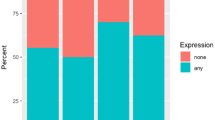Abstract
Receptor-interacting protein kinase 1 (RIP1K) and RIP3K belong to RIPK family, which regulate cell survival and cell death. In the present investigation, the expression levels of RIP1K and RIP3K were evaluated in the 30 malignant, 15 benign, and 20 normal breast tissues, and their correlation with clinicopathological characteristics was also studied. The expression levels of RIP1K and RIP3K were determined, by western blot analysis. The relative RIP1K expression was significantly higher in the malignant and benign tumors when compared to those of normal tissues (P < 0.0001 and P < 0.001, respectively). However, the expression level of RIP3K was significantly lower in the malignant tumors than those of normal and benign values (P < 0.001 and P < 0.01, respectively). Positive significant correlation was found for RIP1K expression with tumor size (P < 0.001), grades (P < 0.0001), and c-erbB2 (P < 0.001), but negative significant correlation was detected with patient’s age (P < 0.001), estrogen receptor (ER) (P < 0.001), progesterone receptor (PR) (P < 0.01), and P53 (P<0.01) status. RIP3K expression was significantly lower in the pre-menopauses (P < 0.01), grade III (P < 0.05), ER-negative (P < 0.05), and c-erbB2-negative malignant tumors, but no correlation was detected with tumor size, PR, and P53 status. No significant correlation was observed for RIP1K and RIP3K expressions with Ki67 and Her2. Based on the present results, it is concluded that reduction of RIP3K expression in the malignant breast tumor might be an important evidence to support the antitumor activity of this enzyme in vivo. However, RIP1K expression was shown to be higher in the malignant breast tumors than those of normal and benign breast tissues, which probably designates as a poor prognostic factor.




Similar content being viewed by others
Abbreviations
- RIP1K:
-
Receptor-interacting protein kinase 1
- RIP3K:
-
Receptor-interacting protein kinase 3
- ER:
-
Estrogen receptor
- PR:
-
Progesterone receptor
References
Ofengeim D, Y. J. Regulation of RIP1 kinase signalling at the crossroads of inflammation and cell death. Nat Rev Mol Cell Biol. 2013;14:727–36.
Moriwaki K, Chan FK. RIP3: a molecular switch for necrosis and inflammation. Genes Dev. 2013;27:1640–9.
Zhang D, Lin J, Han J. Receptor-interacting protein (RIP) kinase family. Cell Mol Immunol. 2010;7:243–9.
Cho YS, Challa S, Moquin D, Genga R, Ray TD, Guildford M, et al. Phosphorylation-driven assembly of the RIP1-RIP3 complex regulates programmed necrosis and virus-induced inflammation. Cell. 2009;137:1112–23.
Sosna J, Voigt S, Mathieu S, Lange A, Thon L, Davarnia P, et al. TNF-induced necroptosis and PARP-1-mediated necrosis represent distinct routes to programmed necrotic cell death. Cell Mol Life Sci. 2014;71:331–48.
Cho Y, McQuade T, Zhang H, Zhang J, Chan FK. RIP1-dependent and independent effects of necrostatin-1 in necrosis and t cell activation. PLoS One. 2011;6, e23209.
Green DR, Oberst A, Dillon CP, Weinlich R, Salvesen GS. RIPK-dependent necrosis and its regulation by caspases: a mystery in five acts. Mol Cell. 2011;44:9–16.
Maki JL, Tres Brazell J, Teng X, Cuny GD, Degterev A. Expression and purification of active receptor interacting protein 1 kinase using a baculovirus system. Protein Expr Purif. 2013;89:156–61.
Bertrand MJ, Milutinovic S, Dickson KM, Ho WC, Boudreault A, Durkin J, et al. cIAP1 and cIAP2 facilitate cancer cell survival by functioning as E3 ligases that promote RIP1 ubiquitination. Mol Cell. 2008;30:689–700.
Ramnarain DB, Paulmurugan R, Park S, Mickey BE, Asaithamby A, Saha D, et al. RIP1 links inflammatory and growth factor signaling pathways by regulating expression of the EGFR. Cell Death Differ. 2008;15:344–53.
Moriwaki K, Bertin J, Gough PJ, Orlowski GM, Chan FK. Differential roles of RIPK1 and RIPK3 in TNF-induced necroptosis and chemotherapeutic agent-induced cell death. Cell Death Dis. 2015;6, e1636.
O'Donnell MA, Perez-Jimenez E, Oberst A, Ng A, Massoumi R, Xavier R, et al. Caspase 8 inhibits programmed necrosis by processing cyld. Nat Cell Biol. 2011;13:1437–42.
Feoktistova M, Leverkus M. Programmed necrosis and necroptosis signalling. FEBS J. 2015;282:19–31.
Su X, Wang H, Kang D, Zhu J, Sun Q, Li T, et al. Necrostatin-1 ameliorates intracerebral hemorrhage-induced brain injury in mice through inhibiting RIP1/RIP3 pathway. Neurochem Res. 2015;40:643–50.
Vandenabeele P, Grootjans S, Callewaert N, Takahashi N. Necrostatin-1 blocks both RIPK1 and ido: consequences for the study of cell death in experimental disease models. Cell Death and Differentiation. 2013;20:185–7.
Declercq W, Vanden Berghe T, Vandenabeele P. RIP kinases at the crossroads of cell death and survival. Cell. 2009;138:229–32.
Salami S, Karami-Tehrani F. Biochemical studies of apoptosis induced by tamoxifen in estrogen receptor positive and negative breast cancer cell lines. Clin Biochem. 2003;36:247–53.
Tavakoli-Yaraki M, Karami-Tehrani F, Salimi V, Sirati-Sabet M. Induction of apoptosis by trichostatin a in human breast cancer cell lines: Involvement of 15-LOX-1. Tumour Biol. 2013;34:241–9.
Aghaei M, Karami-Tehrani F, Salami S, Atri M. Adenosine deaminase activity in the serum and malignant tumors of breast cancer: the assessment of isoenzyme ADA1 and ADA2 activities. Clin Biochem. 2005;38:887–91.
Zhou W, Yuan J. Necroptosis in health and diseases. Seminars in cell and developmental biology. 2014;35:14–23.
de Almagro MC, Vucic D. Necroptosis: pathway diversity and characteristics. Seminars in cell and developmental biology. 2015;39:56–62.
Wang Q, Chen W, Xu X, Li B, He W, Padilla MT, et al. RIP1 potentiates BPDE-induced transformation in human bronchial epithelial cells through catalase-mediated suppression of excessive reactive oxygen species. Carcinogenesis. 2013;34:2119–28.
Wang Q, Chen W, Bai L, Chen W, Padilla MT, Lin AS, et al. Receptor-interacting protein 1 increases chemoresistance by maintaining inhibitor of apoptosis protein levels and reducing reactive oxygen species through a microRNA-146a-mediated catalase pathway. J Biol Chem. 2014;289:5654–63.
Yu S, Hou D, Chen P, Zhang Q, Lv B, Ma Y, et al. Adenosine induces apoptosis through TNFR1/RIPK1/p38 axis in colon cancer cells. Biochem Biophys Res Commun. 2015;460:759–65.
Liu XY, Lai F, Yan XG, Jiang CC, Guo ST, Wang CY, et al. RIP1 kinase is an oncogenic driver in melanoma. Cancer Res. 2015;75:1736–48.
Park S, Hatanpaa KJ, Xie Y, Mickey BE, Madden CJ, Raisanen JM, et al. The receptor interacting protein 1 inhibits p53 induction through nf-kappab activation and confers a worse prognosis in glioblastoma. Cancer Res. 2009;69:2809–16.
He S, Wang L, Miao L, Wang T, Du F, Zhao L, et al. Receptor interacting protein kinase-3 determines cellular necrotic response to TNF-alpha. Cell. 2009;137:1100–11.
Shahsavari Z, Karami-Tehrani F, Salami S, Ghasemzadeh M. RIP1K and RIP3K provoked by shikonin induces cell cycle arrest in the triple negative breast cancer cell line, MDA-MB-468: necroptosis as a desperate programmed suicide pathway. Tumor Biology. 2015.
Koo GB, Morgan MJ, Lee DG, Kim WJ, Yoon JH, Koo JS, et al. Methylation-dependent loss of RIP3 expression in cancer represses programmed necrosis in response to chemotherapeutics. Cell Res. 2015;25:707–25.
Idirisinghe PK, Thike AA, Cheok PY, Tse GM, Lui PC, Fook-Chong S, et al. Hormone receptor and c-erbB2 status in distant metastatic and locally recurrent breast cancer. pathologic correlations and clinical significance. Am J Clin Pathol. 2010;133:416–29.
Lee A, Park WC, Yim HW, Lee MA, Park G, Lee KY. Expression of c-erbB2, cyclin D1 and estrogen receptor and their clinical implications in the invasive ductal carcinoma of the breast. Jpn J Clin Oncol. 2007;37:708–14.
Inwald EC, Klinkhammer-Schalke M, Hofstädter F, Zeman F, Koller M, Gerstenhauer M, et al. Ki-67 is a prognostic parameter in breast cancer patients: results of a large population-based cohort of a cancer registry. Breast Cancer Res Treat. 2013;139:539–52.
Panjehpour M, Karami-Tehrani F. An adenosine analog (IB-MECA) inhibits anchorage-dependent cell growth of various human breast cancer cell lines. Int J Biochem Cell Biol. 2004;36:1502–9.
Hashemi M, Karami-Tehrani F, Ghavami S, Maddika S, Los M. Adenosine and deoxyadenosine induces apoptosis in oestrogen receptor-positive and -negative human breast cancer cells via the intrinsic pathway. Cell Prolif. 2005;38:269–85.
Panjehpour M, Karami-Tehrani F. Adenosine modulates cell growth in the human breast cancer cells via adenosine receptors. Oncol Res. 2007;16:575–85.
Aghaei M, Panjehpour M, Karami-Tehrani F, Salami S. Molecular mechanisms of A3 adenosine receptor-induced G1 cell cycle arrest and apoptosis in androgen-dependent and independent prostate cancer cell lines: Involvement of intrinsic pathway. J Cancer Res Clin Oncol. 2011;137:1511–23.
Acknowledgments
Part of this work was supported by a MSc grant from Tarbiat Modares University. We thank the cancer surgery department of Iran’s Day and Bahman Hospitals. We also thank Mrs. Batoul Etemadi-Kia, lab expert, for her kind assistance.
Author information
Authors and Affiliations
Corresponding author
Ethics declarations
Conflicts of interest
None
Rights and permissions
About this article
Cite this article
Karami-Tehrani, F., Malek, A.R., Shahsavari, Z. et al. Evaluation of RIP1K and RIP3K expressions in the malignant and benign breast tumors. Tumor Biol. 37, 8849–8856 (2016). https://doi.org/10.1007/s13277-015-4762-7
Received:
Accepted:
Published:
Issue Date:
DOI: https://doi.org/10.1007/s13277-015-4762-7




